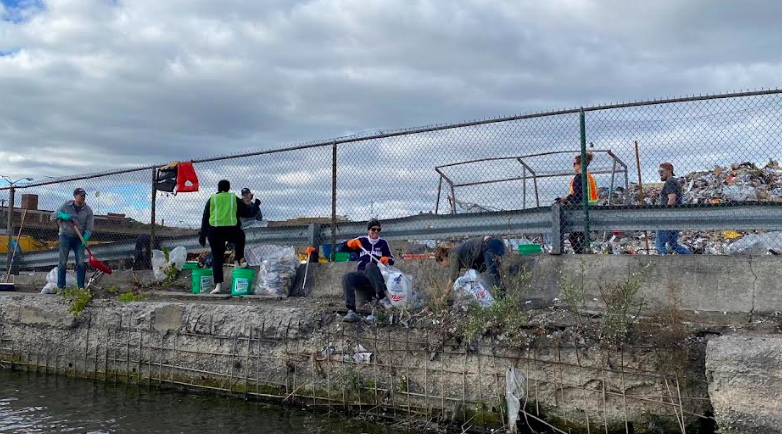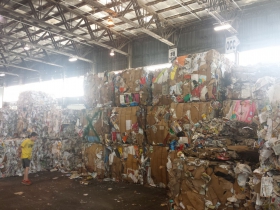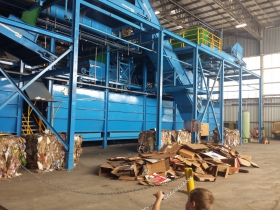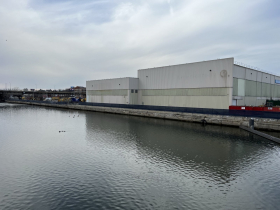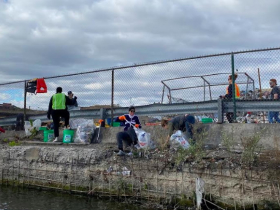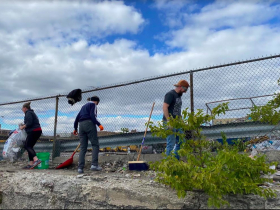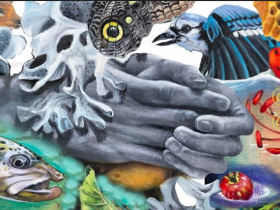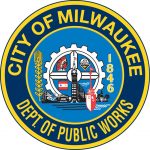Recycling Facility Getting Upgrades To Keep Materials Out of River
New mural will also help beautify Menomonee Valley, highlight native wildlife.
A new project aims to keep materials from Milwaukee’s recycling facility from blowing into the adjacent Menomonee River. Waste in the water near the facility has drawn regulatory attention and violates the facility’s contract with the city. As part of the effort, the project’s organizers will also install a large mural to beautify the area and provide an additional barrier.
On a sunny afternoon in early October, a handful of volunteers in rubber gloves picked their way along the chain link fence between the river and the Materials Recovery Facility at 1401 W. Mt. Vernon Ave. They carried plastic bags they had filled with refuse from the ground along the fence and the concrete shoulder above the river: aluminum cans, flattened Amazon boxes, broken glass, Christmas cards, orphaned puzzle pieces, plastic Sendik’s bags and a cross-section of other waste that Milwaukee residents had at one time tried to recycle. A few yards away, a mound of similar debris—the source of the waste along the fence—sat almost as tall as the facility beside it.
Community members have been organizing similar cleanups at the site for several years, but this event was just one of many facets of the new project. In the months since the cleanup, the project partners have installed a mesh barrier along the length of the fence adjacent to the facility, and in April they will unveil a 15-panel mural by Milwaukee-based artist Nova Czarnecki facing the same stretch of river.
Three nonprofit organizations, Menomonee Valley Partners (MVP), Milwaukee Riverkeeper and Keep Greater Milwaukee Beautiful (KGMB), are working on the initiative alongside the Department of Public Works and the facility’s private operator, Resource Recovery Systems, on the initiative. Waukesha County and the City of Waukesha also send their recycling to the facility.
In early 2020, MVP secured a Fund for Lake Michigan grant for the initiative. The grant will also cover the cost of the barrier and mural.
“It really took a public-private project for this to move forward,” Michelle Kramer, MVP’s director of marketing and business development, told Urban Milwaukee. She added that the city had been aware there was cause to revamp that section of fencing for “years and years,” but that it hadn’t had the resources to do so until it was tapped by the nonprofit partners.
The collaborators began searching for a local artist to design panels to be installed along the fence. They hoped to identify an artist experienced with painting local ecology, who could create a piece that encouraged passersby (whether they’re in a kayak or walking on the Hank Aaron State Trail across the river) to consider their own impact on the environment.
When the partners spotted Czarnecki’s mural featuring native birds and fish on a bridge over E. Greenfield Ave. in the Harbor District, “everyone was like, ‘Yes!'” Kramer said.
“Preserving nature and being a part of nature is so important to me,” Czarnecki told Urban Milwaukee. “That’s why I connect nature with figures [in my art]; it’s part of everything.” She told Kramer that she was interested in being involved with the project regardless of its budget.
Small-scale oil paintings are Czarnecki’s primary medium, but her larger-than-life murals can be spotted elsewhere in the area, including on the Mayer Building in the Historic Third Ward, on Sprocket Cafe on S. Kinnickinnic Ave. and in Menomonee Falls. For this project, she used Photoshop to create a collage of hand-painted images. The result will be printed onto each panel.
The 15 panels will feature human figures surrounded by Wisconsin plants and animals. They’re tied together by a line paraphrased from one of Czarnecki’s favorite books, “The Wind in the Willows” by Kenneth Grahame: “What the river hasn’t got is not worth having, and what it doesn’t know is not worth knowing.”
Czarnecki hopes that those who see the piece are “reminded of what it was like walking in nature as a child; how pristine things were,” she said, “That naive wonderland when you’re a child and you’re exploring nature: the scariness of it and the beauty of it.” She also hopes that a renewed appreciation for nature will push Milwaukee residents to consider what they can do to help conserve it.
The MRF is responsible for sorting, baling and shipping materials to plants where they can be converted into new products. KGMB’s Executive Director Zoe Jump said that many buyers of recovered materials are local, and called Milwaukee-area recycling a “closed-loop system.” Ideally, that system involves shipping materials out on the same day they’re received, but as the volunteer cleanup crew observed firsthand back in October, that’s often not the case in practice.
A major cause of waste buildup at the facility is improper recycling, including a phenomenon nicknamed “wishcycling.” Plastic grocery bags, plastic sheeting, lithium batteries and scrap metal cannot currently be accepted in curbside recycling bins, but well-intentioned civilians often take a chance on placing items like these in their bins.
“Wishcycling” can cause far more harm than good said DPW sanitation services manager Rick Meyers. Plastic bags and plastic sheeting often become wrapped around processing machinery, and lithium batteries can cause fires inside the facility. A fire at the MRF can cause a delay of up to several months, and supply chain delays brought about by the pandemic have exacerbated interruptions at the facility.
Curbside recycling is still delivered to the facility while it’s temporarily or partially inoperable and begins to build up outside of it. That buildup is the primary source of pollution along the fence. It’s also susceptible to damage from the elements, which means it must be thrown away rather than recycled.
Meyers advised Milwaukee residents to review the city’s guide of recyclable materials. “Everyone should have that list hanging on their fridge,” he said. “If it’s not a target material that we tell you we want, then we don’t want it.”
Milwaukee Riverkeeper’s Cheryl Nenn said that MRF employees and managers “are doing their job, which is making sure we’re recycling, but they need to prioritize cleanup as well.”
Resource Recovery Systems’ contract with the city requires that the area outside of the facility be kept as clean as possible, and Nenn said that Riverkeeper has not observed the facility upholding that part of the contract. “It’s been a frustrating couple of years, frankly,” she said. “It’s been an area of tension.”
While there are no quantitative data regarding the source of the waste in that section of the Menomonee River, Kramer mentioned that the City of Milwaukee has received a citation from the Wisconsin Department of Natural Resources regarding contamination at the site. Nenn said that before the mesh barrier was installed, she often received photos that kayakers had taken of debris falling into the water.
Waste falling in the river “has not been a part of [the Department of Public Works’s] story,” Meyers said. “It’s been alleged by others, but we’ve never been a primary witness.”
He continued, “I’m proud of these partnerships, and I want to continue this kind of collaboration… I know the facility has had some challenges, and we appreciate that people are understanding that we’re doing our best and have the public interest in mind.”
Kramer said that MVP is “glad to be having a productive dialogue and partnership with” DPW, and that they have “the right stakeholders at the table to continue the positive momentum around the facility.”
She’s looking forward to unveiling Czarnecki’s art to the public this spring and to MVP’s other upcoming projects, including an initiative to increase tree canopy coverage throughout the Menomonee Valley.
The artwork is tentatively slated to be unveiled on Earth Day, April 22.
Photos
If you think stories like this are important, become a member of Urban Milwaukee and help support real, independent journalism. Plus you get some cool added benefits.

